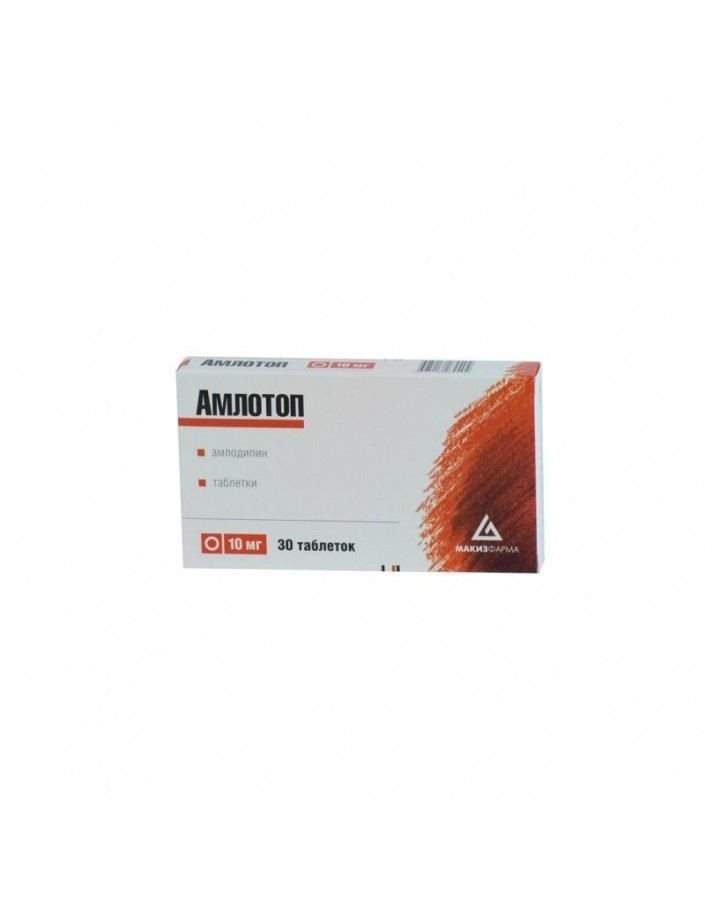




Security policy (edit with Customer reassurance module)

Delivery policy (edit with Customer reassurance module)

Return policy (edit with Customer reassurance module)
Pills white or almost white flat-cylindrical shape. (Amlodipine besyat in terms of Amlodipine 5 - 10 mg)
30 pieces packaged.
Antianginal, hypotensive. Amlotop, by binding to dihydropyridine receptors, blocks Calcium channels, reduces the transmembrane transition of calcium ions into the cell (to a greater extent in vascular smooth muscle cells than cardiomyocytes).
Arterial hypertension (monotherapy or in combination with other antihypertensive drugs); angina (including angina, vasospastic stenocardia (Prinzmetal stenocardia); silent myocardial ischemia, decompensated chronic heart failure (adjuvant therapy).
The initial dose Amlotop - 5 mg 1 time per day; maximum dose - 10 mg 1 time per day
Hypersensitivity including to other dihydropyridine derivatives, severe hypotension, collapse, cardiogenic shock, pregnancy and lactation, age up to 18 years (efficacy and safety have not been established).
With care: abnormal liver function, sick sinus syndrome (severe bradycardia, tachycardia), decompensated chronic heart failure,mild or moderate arterial hypotension, aortic stenosis, mitral stenosis, hypertrophic obstructive cardiomyopathy, acute myocardial infarction (and within 1 month after), diabetes mellitus, impaired lipid profile, old age.
Since the cardiovascular system: palpitations, shortness of breath, marked reduction in blood pressure, fainting, vasculitis, edema (ankles and feet), "flushes" of blood to the face; rarely - rhythm disturbances (bradycardia, ventricular tachycardia, atrial flutter), chest pain, orthostatic hypotension; very rarely - the development or aggravation of heart failure, extrasystoles, migraine.
From the side of the central nervous system: headache, dizziness, fatigue, drowsiness, mood changes, convulsions; rarely - loss of consciousness, hypesthesia, nervousness, paresthesia, tremor, vertigo, asthenia, malaise, insomnia, depression, unusual dreams; very rarely - ataxia, apathy, agitation, amnesia.
On the part of the digestive tract: nausea, vomiting, epigastric pain; rarely, pancreatitis, dry mouth, flatulence, gingival hyperplasia, constipation or diarrhea; very rarely - gastritis, increased appetite.
On the part of the urogenital system: rarely - pollakiuria, painful urge to urinate, nocturia, impaired sexual function (including reduced potency); very rarely - dysuria, polyuria.
For the skin: very rarely xerodermia, alopecia, dermatitis, purpura, discoloration of the skin.
Allergic reactions: pruritus, rash (including erythematous, maculopapular, urticaria), angioedema.
On the part of the musculoskeletal system: rarely - arthralgia, arthrosis, myalgia (with prolonged use); very rarely - myasthenia
During the period of treatment, control over body weight and sodium consumption, the appointment of an appropriate diet is necessary. Tooth hygiene should be maintained and the dentist visited frequently (to prevent soreness, bleeding and gum hyperplasia). Dosing regimen for the elderly is the same as for patients of other age groups. With increasing doses, Amlotop requires careful monitoring of elderly patients. The drug does not affect plasma concentrations of K +, glucose, triglycerides, total cholesterol, LDL, uric acid, creatinine and urea nitrogen.
The drug should be stored in a dry, dark place at a temperature not higher than 25 ° C.